Статьи журнала - International Journal of Information Technology and Computer Science
Все статьи: 1165
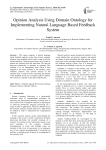
Opinion Analysis Using Domain Ontology for Implementing Natural Language Based Feedback System
Статья научная
This paper proposes a natural language based feedback analysis system that extracts semantic relations from feedback data in order to map it with the domain ontology. After pre-processing a set of words or phrases are extracted from the input data. The data are analyzed semantically to interpret its meaning. This meaning is in an intermediate form which is then mapped to the terms defined in the ontology using similarity function. The opinion analysis of the semantic data is carried out for measuring the polarity of the feedback by the use of opinion analysis method. The system is evaluated on the input feedback data.
Бесплатно

Optical Many Casting Using QoS Depend Layer Aware Mechanism
Статья научная
Many distributed applications require a group of destinations to be coordinated to a single source. Multicasting is a communication paradigm to implement these distributed applications. In multicasting, at least one of the member in the group cannot satisfy the service requirement of the application, the multicast request said to be blocked. On the contrary in manycasting, destinations can join or leave the group, depending upon whether it satisfies the service requirement or not. Manycasting is performed over optical burst-switched (OBS) networks based on multiple qualities of service (QoS) constraints. The multiple constraints can be in the form of physical layer impairments, transmission delay, and reliability of the link. Destinations qualify only if they satisfy the Qos constraints. We develop a simple yet efficient routing algorithm which is based on the classic shortest path algorithm. The proposed layer aware FEC (L-FEC) generates repair symbols so that protection of less important dependency layers can be used with protection of more important layers for combined error correction.
Бесплатно
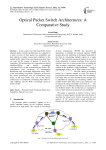
Optical Packet Switch Architectures: A Comparative Study
Статья научная
In this paper four fiber-loop-buffer based photonic packet switched architectures are compared. It is done in terms of their packet loss probability and their optical cost under various load conditions for the random traffic model. The recirculating type delay lines are used for the storage of packets to resolve the contention. The architectures use semiconductor optical amplifiers(SOAs) and tunable wavelength converters(TWCs) in the recirculating loop buffer. The architectures have advantage of simultaneous Read/Write and, wavelength reallocation using TWCs in the recirculating loop buffer. Therefore, it improves the switch performance over the architectures using SOAs in the loop buffer. The cost of the various architectures is evaluated by considering FCC (fiber-to-chip coupling) and the WSU (wavelength speed up factor) model.
Бесплатно
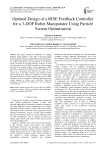
Статья научная
This paper presents an application of recently proposed robust integral of the sign of the error (RISE) feedback control scheme for a three degrees-of-freedom (DOF) robot manipulator tracking problem. This method compensates for nonlinear disturbances and uncertainties in the dynamic model, and results in asymptotic trajectory tracking. To avoid selecting parameters of the RISE controller by time-consuming trial and error method, particle swarm optimization (PSO) algorithm is employed. The objective of the PSO algorithm is to find a set of parameters that minimizes the mean of root squared error as the fitness function. The proposed method attains tracking goal, without any chattering in control input. Indeed, the existence of a unique integral sign term in the RISE controller avoids the occurrence of chattering phenomenon that usually happens in sliding mode controllers. Numerical simulations demonstrate the effectiveness of the proposed control scheme.
Бесплатно

Optimal PID design for control of active car suspension system
Статья научная
This research is based on the determination of the parameters of the PID and fractional-order PID controllers designed for quarter-car suspension system. Initially, without considering the active suspension structure, the performance of the passive suspension system under different wheel load index is presented by using the transfer function of the system. Then, by adding a wheel-load, the classical PID controller is designed and applied to the current controlled hydraulic actuator as a part of active suspension system. The parameters of this controller are determined by three heuristic optimization algorithms; Particle Swarm Optimization (PSO), Differential Evolution (DE) and Gravitational Search Algorithm (GSA). As the second part of this study after evaluating the performance of classical PID controller, fractional-order PID controller is designed and applied to the problem to improve the performance of the classical PID controller. Similarly, the parameters of this controller are also obtained by using the same optimization algorithms. In the paper, for modeling the road, instead of sinusoidal (road with hill) or random changes, a saw tooth signal is preferred as a relatively harder condition. Implementation results are showed that the performance of the fractional-order PID controller is much better that PID controller and also instead of relatively complex and expensive controller, it is possible to use fractional-order PID controller for the problem.
Бесплатно

Optimization for manufacturing system based on Pheromone
Статья научная
A new optimization approach, called pheromone, which comes from the collective behavior of ant colonies for food foraging is proposed to optimize task allocation. These ants spread pheromone information and make global information available locally; thus, an ant agent only needs to observe its local environment in order to account for nonlocal concerns in its decisions. This approach has the capacity for task allocation model to automatically find efficient routing paths for processing orders and to reduce communication overhead, which exists in contract net protocol, in shop floor control system. An example confirms that a pheromone-based optimization approach has an excellent allocation performance in shop floor.
Бесплатно
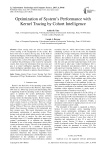
Optimization of System's Performance with Kernel Tracing by Cohort Intelligence
Статья научная
Linux tracing tools are used to record the events running in the background on the system. But these tools lack to analyze the log data. In the field of Artificial Intelligence Cohort Intelligence (CI) is recently proposed technique, which works on the principle of self-learning within a cohort. This paper presents an approach to optimize the performance of the system by tracing the system, then extract the information from trace data and pass it to cohort intelligence algorithm. The output of cohort intelligence algorithm shows, how the load of the system should be balanced to optimize the performance.
Бесплатно
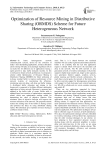
Статья научная
In future heterogeneous network communication systems, driven by the evolution of today’s most demanding applications, resource allocation and its mining will play an increasingly significant role in our daily life for different use of applications facing a rapid growth in data traffic demands recently. In this work based on future network architecture, we proposed a scheme called Optimization of Resource Mining in Distributive Sharing (ORMDS) for better utilization of in-house residual buffer to improve performance of the network in-terms of maximizing the efficiency, minimizing network delay, call drop and buffer mining. A distributed buffer allocation and mining in the framework is proposed to facilitate different multimedia application in future network. Resource is measured and updated in the buffer table of router. Buffer table is updated based on execution of optimization computation model, which uses optimization seeking model for determining the value of objective function. This minimum value of objective function will improve the resource utilization of the network. The proposed scheme reduces the mining time of the buffer in sharing system and optimizes the delay by using distributed sharing option. This ultimately gives optimum resource sharing at a different instant of time.
Бесплатно

Статья научная
This paper presents an optimized speech compression algorithm using discrete wavelet transform, and its real time implementation on fixed-point digital signal processor (DSP). The optimized speech compression algorithm presents the advantages to ensure low complexity, low bit rate and achieve high speech coding efficiency, and this by adding a voice activity detector (VAD) module before the application of the discrete wavelet transform. The VAD module avoids the computation of the discrete wavelet coefficients during the inactive voice signal. In addition, a real-time implementation of the optimized speech compression algorithm is performed using fixed-point processor. The optimized and the original algorithms are evaluated and compared in terms of CPU time (sec), Cycle count (MCPS), Memory consumption (Ko), Compression Ratio (CR), Signal to Noise Ratio (SNR), Peak Signal to Noise Ratio (PSNR) and Normalized Root Mean Square Error (NRMSE).
Бесплатно
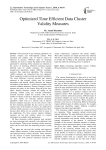
Optimized time efficient data cluster validity measures
Статья научная
The main task of any clustering algorithm is to produce compact and well-separated clusters. Well separated and compact type of clusters cannot be achieved in practice. Different types of clustering validation are used to evaluate the quality of the clusters generated by clustering. These measures are elements in the success of clustering. Different clustering requires different types of validity measures. For example, unsupervised algorithms require different evaluation measures than supervised algorithms. The clustering validity measures are categorized into two categories. These categories include external and internal validation. The main difference between external and internal measures is that external validity uses the external information and internal validity measures use internal information of the datasets. A well-known example of the external validation measure is Entropy. Entropy is used to measure the purity of the clusters using the given class labels. Internal measures validate the quality of the clustering without using any external information. External measures require the accurate value of the number of clusters in advance. Therefore, these measures are used mainly for selecting optimal clustering algorithms which work on a specific type of dataset. Internal validation measures are not only used to select the best clustering algorithm but also used to select the optimal value of the number of clusters. It is difficult for external validity measures to have predefined class labels because these labels are not available often in many of the applications. For these reasons, internal validation measures are the only solution where no external information is available in the applications. All these clustering validity measures used currently are time-consuming and especially take additional time for calculations. There are no clustering validity measures which can be used while the clustering process is going on. This paper has surveyed the existing and improved cluster validity measures. It then proposes time efficient and optimized cluster validity measures. These measures use the concept of cluster representatives and random sampling. The work proposes optimized measures for cluster compactness, separation and cluster validity. These three measures are simple and more time efficient than the existing clusters validity measures and are used to monitor the working of the clustering algorithms on large data while the clustering process is going on.
Бесплатно

Optimizing PI Controller for SEPIC Converter with Optimization Algorithm
Статья научная
This paper refers to work evaluating the performance of PI controllers integrated with optimization techniques designed for Single Ended Primary Inductance Converters (SEPIC). With the SEPIC converter, a constant voltage output can be retained while switching a range of dc voltages. Performance of PI controller has been combined with Artificial Bee Colony (ABC) Algorithm, Particle swarm optimization (PSO) Algorithm, Whale optimization algorithm (WOA). In this research, a performance analysis of the SEPIC dc-dc converter controller constructed with the aforementioned optimization strategies is carried out. Statistics proves WOA provides best stability exhibited with fast response when compared to other optimization techniques.
Бесплатно

Optimizing QoS for Multimedia Services in Next Generation Network Based on ACO Algorithm
Статья научная
In Next Generation Network (NGN), the backbone of the overall network architecture will be IP network, supporting different access network technologies and types of traffics. NGN will provide advanced services, such as Quality of Service (QoS) guarantees, to users and their applications. Factors affecting the QoS in NGN are speech encoders, delay, jitter, packet loss and echo. The negotiation and dynamic adaptation of QoS is currently considered to be one of the key features of the NGN concept. In this paper, I propose a novel Ant Colony Optimization algorithm to solve model of the optimal QoS for multimedia services in the NGN. Simulation results show that my new approach has achieved near optimal solutions. Comparison of experimental results with a recently researches shows that the proposed algorithm is better performance and it can meets the demand of the optimal QoS for multimedia services in NGN.
Бесплатно
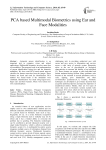
PCA based Multimodal Biometrics using Ear and Face Modalities
Статья научная
Automatic person identification is an important task in computer vision and related applications. Multimodal biometrics involves more than two modalities. The proposed work is an implementation of person identification fusing face and ear biometric modalities. We have used PCA based neural network classifier for feature extraction from the images. These features are fused and used for identification. PCA method was found better if the modalities were combined. Identification was made using Eigen faces, Eigen ears and their features. These were tested over own created database.
Бесплатно

Статья научная
The Marksheet Generator is flexible for generating progress mark sheet of students. This system is mainly based in the database technology and the credit based grading system (CBGS). The system is targeted to small enterprises, schools, colleges and universities. It can produce sophisticated ready-to-use mark sheet, which could be created and will be ready to print. The development of a marksheet and gadget sheet is focusing at describing tables with columns/rows and sub-column sub-rows, rules of data selection and summarizing for report, particular table or column/row, and formatting the report in destination document. The adjustable data interface will be popular data sources (SQL Server) and report destinations (PDF file). Marksheet generation system can be used in universities to automate the distribution of digitally verifiable mark-sheets of students. The system accesses the students’ exam information from the university database and generates the gadget-sheet Gadget sheet keeps the track of student information in properly listed manner. The project aims at developing a marksheet generation system which can be used in universities to automate the distribution of digitally verifiable student result mark sheets. The system accesses the students’ results information from the institute student database and generates the mark sheets in Portable Document Format which is tamper proof which provides the authenticity of the document. Authenticity of the document can also be verified easily.
Бесплатно

Статья научная
Proposed the PID controller parameters tuning method based-on New Luus-Jaakola (NLJ) algorithm and satisfaction idea. According to the different requirements of each performance index, designed the satisfaction function with fuzzy constraint attributes, and then determined the comprehensive satisfaction function for PID tuning by NLJ algorithm. Provided the steps of PID controller parameters tuning based on the NLJ algorithm and satisfaction, and applied this tuning method to the cascade control system of superheated steam temperature for Power Station Boiler. Finally the simulation and experiment results have shown the proposed method has good dynamic and static control performances for this complicated superheated steam temperature control system.
Бесплатно
PTSLGA: A Provenance Tracking System for Linked Data Generating Application
Статья научная
Tracking provenance of RDF resources is an important task in Linked Data generating applications. It takes on a central function in gathering information as well as workflow. Various Linked Data generating applications have evolved for converting legacy data to RDF resources. These data belong to bibliographic, geographic, government, publications, and cross-domains. However, most of them do not support tracking data and workflow provenance for individual RDF resources. In such cases, it is required for those applications to track, store and disseminate provenance information describing their source data and involved operations. In this article, we introduce an approach for tracking provenance of RDF resources. Provenance information is tracked during the conversion process and it is stored into the triple store. Thereafter, this information is disseminated using provenance URIs. The proposed framework has been analyzed using Harvard Library Bibliographic Datasets. The evaluation has been made on datasets through converting legacy data into RDF and Linked Data with provenance. The outcome has been quiet promising in the sense that it enables data publishers to generate relevant provenance information while taking less time and efforts.
Бесплатно

Parallel DBSCAN Clustering Algorithm Using Hadoop Map-reduce Framework for Spatial Data
Статья научная
Data clustering is the first step for future applications of big data analysis. It is a driving model for Artificial Intelligence and Machine Learning architectures. Processing large volumes of data in faster mode is a big challenge in these applications. which requires fast and efficient algorithms for handling big data. Parallel clustering algorithms are one promising design, which increases the speed of handling such big data. In this paper, a parallel algorithm for clustering a spatial dataset called the P-DBSCAN algorithm is implemented using Hadoop map-reduce framework. This research paper signifies the improvement for data clustering in data analytic applications. The new P-DBSCAN algorithm is executed over generated dataset. The result of this parallel algorithm is compared with existing DBSCAN algorithm to show improvement of runtime performance. This work offers an increase in the performance of execution time. In addition, the outcome of P-DBSCAN shows how to resolve the scalability problem of a large data set.
Бесплатно

Parallel Implementation of Color Based Image Retrieval Using CUDA on the GPU
Статья научная
Most image processing algorithms are inherently parallel, so multithreading processors are suitable in such applications. In huge image databases, image processing takes very long time for run on a single core processor because of single thread execution of algorithms. Graphical Processors Units (GPU) is more common in most image processing applications due to multithread execution of algorithms, programmability and low cost. In this paper we implement color based image retrieval system in parallel using Compute Unified Device Architecture (CUDA) programming model to run on GPU. The main goal of this research work is to parallelize the process of color based image retrieval through color moments; also whole process is much faster than normal. Our work uses extensive usage of highly multithreaded architecture of multi-cored GPU. An efficient use of shared memory is needed to optimize parallel reduction in CUDA. We evaluated the retrieval of the proposed technique using Recall, Precision, and Average Precision measures. Experimental results showed that parallel implementation led to an average speed up of 6.305×over the serial implementation when running on a NVIDIA GPU GeForce 610M. The average Precision and the average Recall of presented method are 53.84% and 55.00% respectively.
Бесплатно
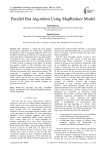
Parallel bat algorithm using mapreduce model
Статья научная
Bat Algorithm is among the most popular meta-heuristic algorithms for optimization. Traditional bat algorithm work on sequential approach which is not scalable for optimization problems involving large search space, huge fitness computation and having large number of dimensions E.g. stock market strategies therefore parallelizing meta-heuristics to run on parallel machines to reduce runtime is required. In this paper, we propose two parallel variants of Bat Algorithm (BA) using MapReduce parallel programming model proposed by Google and have used these two variants for solving the Software development effort optimization problem. The experiment is conducted using Apache Hadoop implementation of MapReduce on a cluster of 6 machines. These variants can be used to solve various complex optimization problems by simply adding more hardware resources to the cluster and without changing the proposed variant code.
Бесплатно
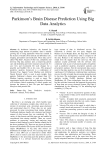
Parkinson's Brain Disease Prediction Using Big Data Analytics
Статья научная
In healthcare industries, the demand for maintaining large amount of patients' data is steadily growing due to rising population which has resulted in the increase of details about clinical and laboratory tests, imaging, prescription and medication. These data can be called "Big Data", because of their size, complexity and diversity. Big data analytics aims at improving patient care and identifying preventive measures proactively. To save lives and recommend life style changes for a peaceful and healthier life at low costs. The proposed predictive analytics framework is a combination of Decision Tree, Support Vector Machine and Artificial Neural Network which is used to gain insights from patients. Parkinson's disease voice dataset from UCI Machine learning repository is used as input. The experimental results show that early detection of disease will facilitate clinical monitoring of elderly people and increase the chances of their life span and improved lifestyle to lead peaceful life.
Бесплатно

